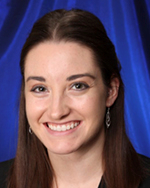First-year student pharmacists at Midwestern University–Glendale complete their training at the American Lung Association.
School-aged children are some busy little humans. They have their plates full with learning, making friends, growing up, and … managing asthma? According to CDC, for close to 9% of children in the Unites States, asthma is an unavoidable part of daily life, one that can be difficult to live with, especially at such a young age. Properly controlling symptoms and avoiding triggers takes time to learn, and requires a teacher with an understanding of special difficulties that children of this age face.
Student pharmacists at the Midwestern University College of Pharmacy in Glendale, AZ, partner with the Phoenix Chapter of the American Lung Association (ALA) to provide asthma education to elementary school children each year. The Open Airways for Schools Program, produced by the ALA, offers a unique opportunity for these students to undergo asthma management training and to bring what they know to children that could most benefit from kid-friendly education.
Hands-on training
The Midwestern students that participate in the community partnership supplement their didactic knowledge of asthma through several hours of ALA training. Since the elementary school students that will be attending the lessons are selected by their school nurse as potentially struggling with uncontrolled asthma, the curriculum and training are very hands-on and in-depth. For this audience in particular, it is vital for these new teachers to be able to address very specific concerns that the kids may have.
Topics covered include signs and symptoms of asthma, demonstrating use of inhalers, spacers, and peak flow meters, and how to engage and explain to a young audience using the Open Airways curriculum. To ensure
success in the classroom, the student pharmacists finish preparing by
practicing their teaching skills on each other for feedback.
Elementary school visits
Following their training sessions, Midwestern students are ready to visit local elementary schools and lead lessons for their students in partnership with the school nurse. Each 2-hour lesson focuses on around 8 to 12 kids and provides them with the tools they need to self-manage their asthma. The student pharmacists who have conducted these lessons had the opportunity to witness first-hand how the knowledge empowers the children to take control of their asthma symptoms.
Joe Naff, a first-year student pharmacist who participated in the program this year, said, “It was clear from my experience that the child not only deserves to, but will most likely, play a more active role in their health management.”
Interacting with school-aged children also gives student pharmacists an opportunity to gain experience with an age group that may not be a common audience during a pharmacy didactic curriculum. For many, working with kids is a chance to gain counseling and teaching skills that target this particular audience, and to simply have some fun with the younger groups who are happy to learn new skills. Naff added, “I also learned to appreciate how willing these children were to learn and participate in lessons.”
A win–win partnership
For the student pharmacists who participate in this partnership, the rewards of this exercise extend far and wide. The Open Airways programming has been shown to be a very effective way to educate children on their inhalers, triggers, and general health management. As a result, participating in this program is a powerful way to have a positive impact on children’s health and bolster their confidence in taking control of their asthma. For the student pharmacists who get involved with the program, not only do they get to learn and apply their increasing pharmacy knowledge, they also get to see how their skills are a valuable and lasting asset to the members of their community.
Samantha Bustos, a second-year student pharmacist, said of her experience, “I think that this community partnership utilized students well in that they gave us the opportunity to interact with kids in our community and let us apply what we have learned. This will also lead to building a bond of trust between members of our pharmacy career field and those whose well-being matters most to us, our community members.”

Kari Allan is a final-year PharmD candidate at the Midwestern University College of Pharmacy–Glendale.